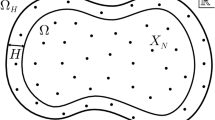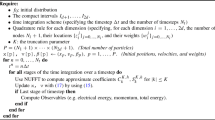Abstract
In this paper, we derive an analytical expression for reproducing kernel particle method (RKPM) shape functions. Based on this, we propose a necessary and sufficient stability condition for general RKPM in arbitrary function space, and illustrate with degenerate cases. By selecting proper basis vectors and the support of the kernel functions, we demonstrate that the RKPM framework allows generating many kinds of shape functions, including the Lagrangian, B-spline and NURBS shape functions.
Similar content being viewed by others
References
Liu WK, Jun S, Zhang YF (1995) Reproducing kernel particle methods. Int J Numer Methods Fluids 20(8–9):1081–1106
Li S, Liu WK (2007) Meshfree particle methods. Springer, Berlin
Chen J-S, Pan C, Wu C-T, Liu WK (1996) Reproducing kernel particle methods for large deformation analysis of non-linear structures. Comput Methods Appl Mech Eng 139(1–4):195–227
Chen J-S, Pan C, Wu C-T (1997) Large deformation analysis of rubber based on a reproducing kernel particle method. Comput Mech 19(3):211–227
Lian Y, Zhang X, Liu Y (2012) An adaptive finite element material point method and its application in extreme deformation problems. Comput Methods Appl Mech Eng 241:275–285
Bessa M, Foster JT, Belytschko T, Liu WK (2014) A meshfree unification: reproducing kernel peridynamics. Comput Mech 53(6):1251–1264
Liu WK, Jun S, Li S, Adee J, Belytschko T (1995) Reproducing kernel particle methods for structural dynamics. Int J Numer Methods Eng 38(10):1655–1679
Liu WK, Chen Y, Jun S, Chen J, Belytschko T, Pan C, Uras R, Chang C (1996) Overview and applications of the reproducing kernel particle methods. Arch Comput Methods Eng 3(1):3–80
Ying Y, Lian Y, Tang S, Liu WK (2018) Enriched reproducing kernel particle method for fractional advection-diffusion equation. Acta Mech Sin 34(3):515–527
Zhou J, Wang X, Zhang Z, Zhang L (2004) On some enrichments of reproducing kernel particle method. Int J Comput Methods 1(03):519–533
Zhou J, Wang X, Zhang Z, Zhang L (2005) Explicit 3-D RKPM shape functions in terms of kernel function moments for accelerated computation. Comput Methods Appl Mech Eng 194(9–11):1027–1035
Liu W-K, Li S, Belytschko T (1997) Moving least-square reproducing kernel methods (i) methodology and convergence. Comput Methods Appl Mech Eng 143(1–2):113–154
Li S, Qian D, Liu WK, Belytschko T (2001) A meshfree contact-detection algorithm. Comput Methods Appl Mech Eng 190(24–25):3271–3292
Han W, Meng X (2001) Error analysis of the reproducing kernel particle method. Comput Methods Appl Mech Eng 190(46–47):6157–6181
Hughes TJ, Cottrell JA, Bazilevs Y (2005) Isogeometric analysis: CAD, finite elements, NURBS, exact geometry and mesh refinement. Comput Methods Appl Mech Eng 194(39–41):4135–4195
Rogers DF (2000) An introduction to NURBS: with historical perspective. Elsevier, Amsterdam
Wang D, Zhang H (2014) A consistently coupled isogeometric-meshfree method. Comput Methods Appl Mech Eng 268:843–870
Marsden MJ (1970) An identity for spline functions with applications to variation-diminishing spline approximation. J Approx Theory 3(1):7–49
Zhang H, Wang D (2017) Reproducing kernel formulation of B-spline and NURBS basis functions: a meshfree local refinement strategy for isogeometric analysis. Comput Methods Appl Mech Eng 320:474–508
Acknowledgements
Lei Zhang and Shaoqiang Tang were supported partially by NSFC under Grant Numbers 11832001, 11890681, and 11988102.
Author information
Authors and Affiliations
Corresponding author
Additional information
Publisher's Note
Springer Nature remains neutral with regard to jurisdictional claims in published maps and institutional affiliations.
Appendices
Appendix A: Illustration for Lemma 1 with \(q=2,n=3\)
When \(q=2, n=3\), we have
The determinant is
where
Expand (61) and assemble the terms according to the same order of components. For example, we take \(P^1_1 Q^j_1 (j=1,2)\) from \(A_{1,j}\) and take \(P^2_2 Q^j_2 (j=1,2)\) from \(A_{2,j}\). The summation is
Thus, (61) becomes
Obviously, we have
Then, we combine the terms corresponding to the same index pair \(\mathrm {det}([(\varvec{Q}_I)^T; (\varvec{Q}_J)^T])\),
Appendix B: Derivatives of the RKPM analytical expression
We can have direct differentiation of the shape functions and get the corresponding analytical expression:
with
\(\alpha \) is an arbitrary variable.
If kernel functions \(\phi _I\) are constant, (67) reduces to
Rights and permissions
About this article
Cite this article
Zhang, L., Tang, S. & Liu, W.K. Analytical expression of RKPM shape functions. Comput Mech 66, 1343–1352 (2020). https://doi.org/10.1007/s00466-020-01904-3
Received:
Accepted:
Published:
Issue Date:
DOI: https://doi.org/10.1007/s00466-020-01904-3




